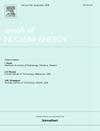核不扩散与反扩散卫星图像数据集的深度学习应用
IF 1.9
3区 工程技术
Q1 NUCLEAR SCIENCE & TECHNOLOGY
引用次数: 0
摘要
本研究考察了深度学习技术在从高分辨率卫星图像中提取人工结构以支持核不扩散和反扩散工作核查过程中的适用性。这项检查依赖于一个定制的数据集和一个开源数据集。定制的数据集使用知名核复合物的卫星图像进行策划,并进一步细化以增强领域相关性。此外,利用注意力U-Net模型,确定了批量大小等参数的最优值,以提高性能。然后在各种来源的核设施卫星图像上对该模型进行了测试,即使应用于不同和复杂的环境,也显示出有效的性能。为了评估模型的稳健性,使用基于像素和基于对象的测试进行了准确性评估。这种双重评价方法对该模型进行了全面分析,突出了它在实际核查任务,特别是与核活动有关的核查任务中的实际效用。虽然检测到一些误报,但所提出的方法能够成功地提取大多数感兴趣的结构。预计这一成就将大大减少分析人员的口译工作量,并为全球核监测应用提供一种可转移的解决办法。本文章由计算机程序翻译,如有差异,请以英文原文为准。
Deep learning applications on satellite imagery datasets for nuclear nonproliferation and counter-proliferation
This study examined the applicability of deep-learning techniques for extracting artificial structures from high-resolution satellite imagery to support verification processes in nuclear nonproliferation and counter-proliferation efforts. This examination relied on a tailored dataset and an open-source dataset. The tailored dataset was curated using satellite images of well-known nuclear complexes and was further refined to enhance domain relevance. Furthermore, using the attention U-Net model, optimal values of parameters such as batch size were determined to enhance performance. The model was then tested on satellite images of nuclear facilities from various sources, demonstrating effective performance even when applied to distinct and complex environments. To assess the robustness of the model, accuracy evaluations were conducted using both pixel-based and object-based tests. This dual evaluation approach provided a comprehensive analysis of the model, highlighting its practical utility for real-world verification tasks, particularly those related to nuclear activities. Although some false positives were detected, the proposed approach enabled the successful extraction of the majority of structures of interest. This achievement is anticipated to substantially reduce the interpretational workload for analysts and offer a transferable solution for global nuclear monitoring applications.
求助全文
通过发布文献求助,成功后即可免费获取论文全文。
去求助
来源期刊

Annals of Nuclear Energy
工程技术-核科学技术
CiteScore
4.30
自引率
21.10%
发文量
632
审稿时长
7.3 months
期刊介绍:
Annals of Nuclear Energy provides an international medium for the communication of original research, ideas and developments in all areas of the field of nuclear energy science and technology. Its scope embraces nuclear fuel reserves, fuel cycles and cost, materials, processing, system and component technology (fission only), design and optimization, direct conversion of nuclear energy sources, environmental control, reactor physics, heat transfer and fluid dynamics, structural analysis, fuel management, future developments, nuclear fuel and safety, nuclear aerosol, neutron physics, computer technology (both software and hardware), risk assessment, radioactive waste disposal and reactor thermal hydraulics. Papers submitted to Annals need to demonstrate a clear link to nuclear power generation/nuclear engineering. Papers which deal with pure nuclear physics, pure health physics, imaging, or attenuation and shielding properties of concretes and various geological materials are not within the scope of the journal. Also, papers that deal with policy or economics are not within the scope of the journal.
 求助内容:
求助内容: 应助结果提醒方式:
应助结果提醒方式:


